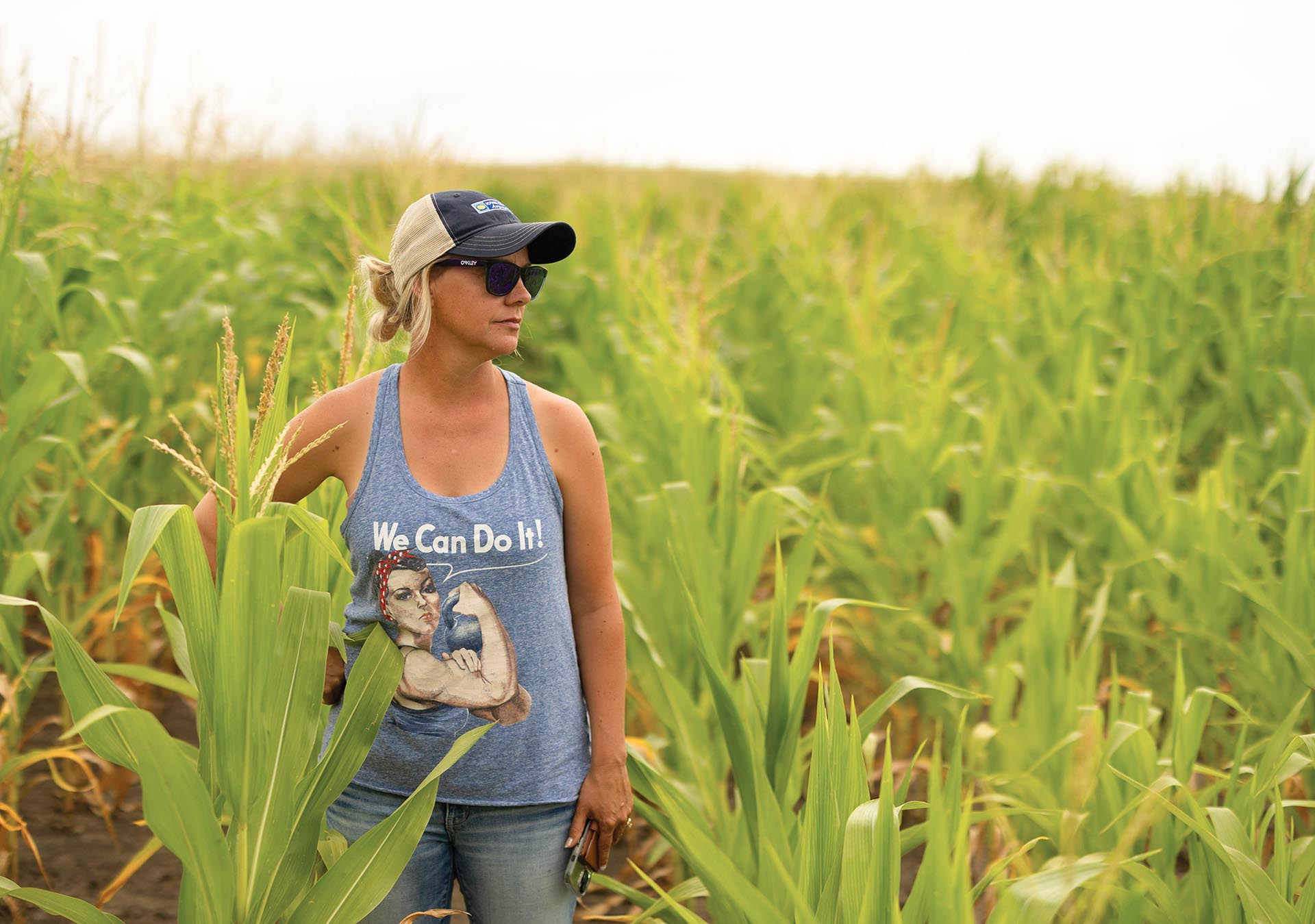
(Photo: Iowa Soybean Association / Joclyn Bushman)
Nitrogen optimization
September 3, 2024 | Kriss Nelson
Iowa Nitrogen Initiative helps farmers with nitrogen needs
There are four Rs to nutrient management: right source, right rate, right time and right place.
To better pinpoint those 4Rs, Iowa Soybean Association (ISA) At-Large Director Aimee Bissell is looking to trials to research how different nitrogen rates perform throughout her fields near Bedford.
For Bissell, learning the proper nitrogen rate that works best on her fields is an environmental and financial priority.
“As Iowans, we need to protect our water quality and water sources, and reducing nitrogen rates is one way we can,” she says.
That’s why Bissell has been a part of Iowa Nitrogen Initiative trials for the past three years.
“The Iowa Nitrogen Initiative is a tool in our toolbox that can help us figure out how to reduce nitrogen loss in our nearby streams. That nitrogen lost is money lost,”
she says.
In the last three years, Bissell has conducted trials to research the effects of varying rates of fall- and spring-applied anhydrous on their no-till soybeans and strip-till corn acres.

Finding an optimal nitrogen rate
Michael Castellano, an Iowa State University professor and leader of the Iowa Nitrogen Initiative, emphasizes the importance of knowing the soil’s capacity to provide nitrogen to the corn plant to better understand the required nitrogen application.
Within the trial, soil samples are taken throughout the growing season, starting with a general fertility and zero-rate grid sample of the soil prior to planting; soil subplot samples and population counts at the V4-V6 stages; ear collection at black layer and a post-harvest subplot
soil sample.
Castellano insists that the plots with zero nitrogen application are crucial for the study, despite some farmers’ concerns.
“The zero nitrogen plots help to understand nitrogen fertilizer use efficiency because a significant portion of the crop’s nitrogen demand is met from organic matter in the soil,” says Castellano.
As part of the Iowa Nitrogen Initiative trials, the Bissells installed three sets of experiments in two of their fields. Each set comprised five different nitrogen application rates: zero, 50 pounds per acre, 100 pounds per acre, 150 pounds per acre and 200 pounds per acre. To observe how the different nitrogen rates performed, the Bissells placed these experiments in areas of the field with varying levels of productivity.
Weather plays a large role in the variation of optimum nitrogen rates, says Melissa Miller, project director for the Iowa Nitrogen Initiative. She says states that use data from trials in the Iowa Nitrogen Initiative over multiple weather years will see improved field-level optimal rate forecasts.

Taking action from results
Over the course of three years of research, Bissell acknowledges they have yet to determine the ideal nitrogen level for their fields. However, their efforts haven’t been entirely lost.
“We have learned it would be advantageous for us to variable rate apply our nitrogen,” she says. “The question remains about what those rates should be. We are learning there are different parts of our fields that may require more nitrogen while others require less.”
Through farmers’ involvement in the Iowa Nitrogen Initiative, ISA Research Agronomist Alex Schaffer says farmers often realize they have been under-applying or over-applying nitrogen. As a result, they can use the knowledge gained from participating in the trial to make more informed decisions about managing fertility.
“We have actually backed down on our pounds per acre of nitrogen,” says Bissell. “We have found we have the best return on investment at a lower rate than we were applying three years ago before we started the trials.”
Bissell estimates they have reduced their pounds per acre of nitrogen by nearly 15 to 20 pounds per acre.
“The study has consistently shown for three years our sweet spot on our farms is at 150 pounds of anhydrous per acre throughout the field,” she says, adding if they can narrow down a variable rate prescription, they expect to further increase their ROI.
Developing a network
Bissell encourages other farmers to work to find their “sweet spot” for their farm’s fertility needs.
“The Iowa Nitrogen Initiative trial is very worthwhile and takes minimal time and effort,” she says.
ISA is partnering with Iowa State University to conduct the Iowa Nitrogen Initiative trial by using its network of research and conservation agronomists to help recruit farmers.
Schaffer says there are no restrictions on management practices. The only requirements are yield maps from previous years, a calibrated yield monitor and access to equipment that can apply nitrogen at variable rates across the field.
“The Iowa Soybean Association is helping farmers make the process as easy as possible, helping them understand the prescriptions and other technical support,” says Schaffer. “In the end, we hope participation in the Iowa Nitrogen Initiative will deliver a higher return on investment by making decisions that help boost nitrogen efficiency.”
Empowering farmers
Schaffer points out another benefit of participating in the Iowa Nitrogen Initiative: Farmers are equipped with the knowledge to potentially create their own variable rate prescriptions.
“The trial is empowering farmers to make evidence-based decisions using hard data from five different rates of nitrogen in their field,” he says. “That is black-and-white evidence to help them move forward to build their own variable rate prescriptions.”
ISA is recruiting farmers to participate in fall-applied trials for crop year 2025. For more information, contact Alex Schaffer at aschaffer@iasoybeans.com.
Back